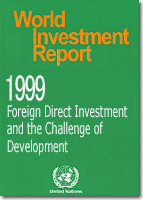|
Published by the United
Nations Conference on Trade and Development - UNCTAD
WORLD INVESTMENT REPORT 1999
Foreign Direct Investment and the Challenge of Development

WIR 99 is the ninth Report in an annual series that has been recognized as
the most up-to-date and comprehensive source of information as well as analysis
regarding foreign direct investment (FDI).
Part I, entitled Trends,examines the most recent global and regional trends
in FDI. It describes the world´s 100 largest TNCs, the 50 largest TNCs in
developing countries and the 25 largest TNCs in Central Europe; analyses the
momentum for an increasing globalization of economies through FDI and the
activities of TNCs; and explores the growing importance of mergers and
acquisitions in fuelling FDI flows. It also reviews recent developments in
bilateral and regional investment agreements including the reasons for the end
of negotiations of the Multilateral Agreement on Investment.
Part II, entitled FDI and the Challenge of Development, looks at the impact
of FDI on key objectives of economic development: increasing financial resources
for investment, enhancing technological capabilities, boosting export
competitiveness, generating and upgrading employment, and protecting the
environment.
The Report concludes that although FDI can yield major economic benefits for
the host country, such benefits can be enhanced through appropriate policies.
Governments therefore have an important role to play in creating the conditions
that attract FDI and in maximizing the positive contribution that FDI can make
to growth and development.
|
Chapter I
GLOBAL TRENDS
The growth of international production is an important part of the process of
globalization. “International production” refers to that part of the production of goods and
services of countries that is controlled and managed by firms headquartered in other countries.
Firms can exercise control of production in countries (“host countries”) other than their own
(“home country”) either through the ownership of a minimum share of equity – that is, a
minimum share in the capital stock or assets – of the enterprises in which the production takes
place, or through contractual (non-equity) arrangements that confer control upon them.
Exercising control and having a voice in the management of an enterprise located abroad
(“foreign affiliate”) – whether through capital investment or through contractual arrangement
– leads to international production.
Firms that engage in international production – transnational corporations (TNCs) –
establish, under the common governance of their headquarters, international production systems
in which factors of production move, to a greater or lesser extent, among units located in different
countries. These systems increasingly cover a variety of activities, ranging from research and
development (R&D) to manufacturing to service functions such as accounting, advertising,
marketing and training, dispersed over host-country locations and integrated to produce final
goods or services. They are also increasingly being established, especially in developed countries,
through mergers between existing firms from different countries or the acquisition of existing |
|
|
| A. |
Trends |
|
| B. |
Geographical and sectoral distribution
|
|
|
Chapter II
REGIONAL TRENDS |
|
| A. |
Developed countries |
|
| B. |
Developing countries |
|
| C. |
Central and Eastern Europe |
|
|
Chapter III
THE LARGEST TRANSNATIONAL CORPORATIONS AND
CORPORATE STRATEGIES |
|
| A. |
The largest transnational
corporations |
|
| B. |
Cross-border Mergers &
Acquisitions |
|
| C. |
Strategic partnering, Mergers &
Acquisitions and their implications for the competitive environment |
|
|
Chapter IV
INVESTMENT POLICY DEVELOPMENTS |
|
| A. |
National policies |
|
| B. |
Developments at the international level
TextB |
|
| PART II |
Chapter V
THE CONTEXT AND ITS CHALLENGE |
|
| A. |
The changing context of development |
|
| B. |
The changing context for TNCs |
|
| C. |
The challenge |
|
|
Chapter VI
INCREASING FINANCIAL RESOURCES AND
INVESTMENT |
|
| A. |
The importance of investment for
development |
|
| B. |
The financial behaviour of TNCs |
|
| C. |
The impact of FDI on financial resources and
investment |
|
| D. |
Conclusions and policy implications |
|
|
Chapter VII
ENHANCING TECHNOLOGICAL CAPABILITIES |
A. |
Technology, learning and
development |
| B. |
Technology generation and transfer: the role
of TNCs |
| C. |
FDI and developing countries: technology
transfer, diffusion and generation |
| D. |
Conclusions and policy implications
|
|
|
Chapter VIII
BOOSTING EXPORT COMPETITIVENESS |
| A. |
The competitiveness challenge |
| B. |
TNC strategies and role in trade |
| C. |
The role of FDI in building export
competitiveness |
| D. |
Conclusions and policy implications |
|
|
Chapter IX
GENERATING EMPLOYMENT AND STRENGTHENING THE SKILLS
BASE |
| A. |
The importance of employment, employment
quality and skills for development |
| B. |
TNC strategies and their implications for
generating employment and building skills |
| C. |
FDI, employment and skills in host developing
countries |
| D. |
Conclusions and policy |
|
Chapter X
PROTECTING THE ENVIRONMENT |
| A. |
The importance of the environment for
development |
| B. |
Environmental strategies of TNCs |
| C. |
The impact of FDI on the environment in host
developing countries |
|
Chapter XI
ASSESSING FDI AND DEVELOPMENT IN THE NEW
COMPETITIVE CONTEXT |
| A. |
The new competitive context |
| B. |
FDI in developing countries |
|
Chapter XII
THE SOCIAL RESPONSIBILITY OF TRANSNATIONAL
CORPORATIONS |
| A. |
The context for the social responsibility of
TNCs |
| B. |
Meanings of corporate social |
| C. |
The growing importance of TNC social
responsibility |
| D. |
Recent developments in corporate social
responsibility |
| E. |
Outlook and policy implications |
|
|
|